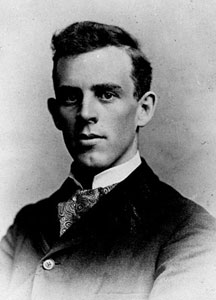Everglades Biographies
David Grandison Fairchild
David Grandison Fairchild was born in East Lansing, Michigan on April
7, 1869. In 1888 Fairchild graduated from Kansas State University of
Agriculture, Manhattan. He also conducted graduate work at the University
of Iowa, Iowa City, and at Rutgers College, New Jersey.
In 1889 Fairchild joined the United States Department of Agriculture
(USDA) in Washington, D.C. as a botanist and plant explorer in the plant
pathology section. Fairchild searched the world for plants of economic and
aesthetic value that might be cultivated in the United States. Excursions
throughout the orient fostered in Fairchild a passion for exploration and
tropical horticulture -- an interest he would pursue throughout this
life.
In 1897-98, Fairchild helped fellow explorer Walter T. Swingle organize
the USDA's Office of Foreign Seed and Plant Introduction; from 1904 to
1928, Fairchild served as its Chairman. During that time, many kinds of
plants were introduced into the country. Dr. Fairchild was instrumental in
establishing several plant introduction gardens throughout the U. S. to
screen plants with a potential to improve the diets and industry of
Americans.
Among the facilities established by the Office of Foreign Seed and
Plant Introduction was a new subtropical laboratory and garden in Miami.
Fairchild's associate Walter Swingle convinced railroad tycoon Henry
Flagler to give the USDA an acre of land along Biscayne Bay to be used for
construction of a laboratory to study plant diseases. He also persuaded
another historic Miamian, Mary Brickell, to give him six acres across
Brickell Avenue from Flagler's plot for use as a plant introduction site.
In 1898 the USDA decided to lease, not own, these properties and the
tropical agricultural program took off in earnest. Fairchild visited the
garden in 1898, his first trip to Miami.
In 1903, Fairchild became acquainted with Alexander Graham Bell and his
family in Washington DC. Two years later, he married Bell's daughter,
Marian Hubbard ("Daisy") Bell, and the couple settled in Chevy Chase,
outside of Washington DC. Their son Alexander ("Sandy") was born in the
summer of 1906; daughter Barbara was born in spring 1909. In 1917, the
Fairchilds began wintering in Coconut Grove. They purchased property at
4013 Douglas Road, naming it "The Kampong" (which means 'a cluster of
houses' in Malay). Fairchild continued to travel all over the world
collecting plant specimens and brought them back to his Coconut Grove
home. In 1928, he and Marian built a two-story residence there, amid some
of his collections. When Fairchild retired several years later, the
Kampong became the family's permanent residence.
A new area of interest developed for Fairchild in 1929 -- the movement
to establish a national park in the southern Everglades. As the first
president of the Tropical Everglades Park Association, Fairchild brought
his considerable reputation to the movement. He wrote essays, accompanied
inspection parties, and provided testimony regarding the region's natural
values.
The plant introduction facility that Swingle and Fairchild established
in Miami moved to southern Dade County in 1921, after the War Department
offered the abandoned Chapman Field to the USDA. On April 26, 1923, the
first trees were planted at the new USDA Plant Introduction Garden at
Chapman Field. The period of great plant explorations continued unabated
through the 1930s, with Fairchild and others bringing thousands of new
plant specimens into the station for propagation
Dr. David Fairchild died on Aug. 6, 1954, in Coconut Grove, Florida. He
is credited with overseeing the introduction of more than 80,000 species
and varieties of plants into the United States, among them the flowering
cherry, Chinese soy bean, pistachios, nectarines, bamboo, avocados, East
Indian mangoes and horseradish. Fairchild also wrote several books,
including Exploring for Plants, (1930) and the
autobiographical The World Was My Garden (1938).
Biography prepared Gail Clement, Florida International
University

Photograph of David Fairchild, 1889.
Photo courtesy of
National Agriculture Library, Special Collections, Galloway
Photograph Album
Excerpt from letter
from David Fairchild to Ruth Owen, regarding Park Committee's inspection
tour of the Everglades, February 1930.
I think we are all
set here for the arrival of the Committee unless something happens on the
eleventh hour... What I have been afraid of is that the committee will not
be able to adjust their senses to such a radical change as that involved
in the shift from a foot of snow to mangos in bloom.
The blimp trip of
course depends on the weather. If the wind is from the North it blows
across the entrance to the hangar and they cannot get the big cigar
out...
Do your best to
get them out of the pullman at seven sharp. I know they will have had two
restless nights and am fearful that this is going to be hard, but am
counting on the fact that they are scientific men and will see the
necessity of action when they have selected to see the whole tip of this
great state in only four days..."



